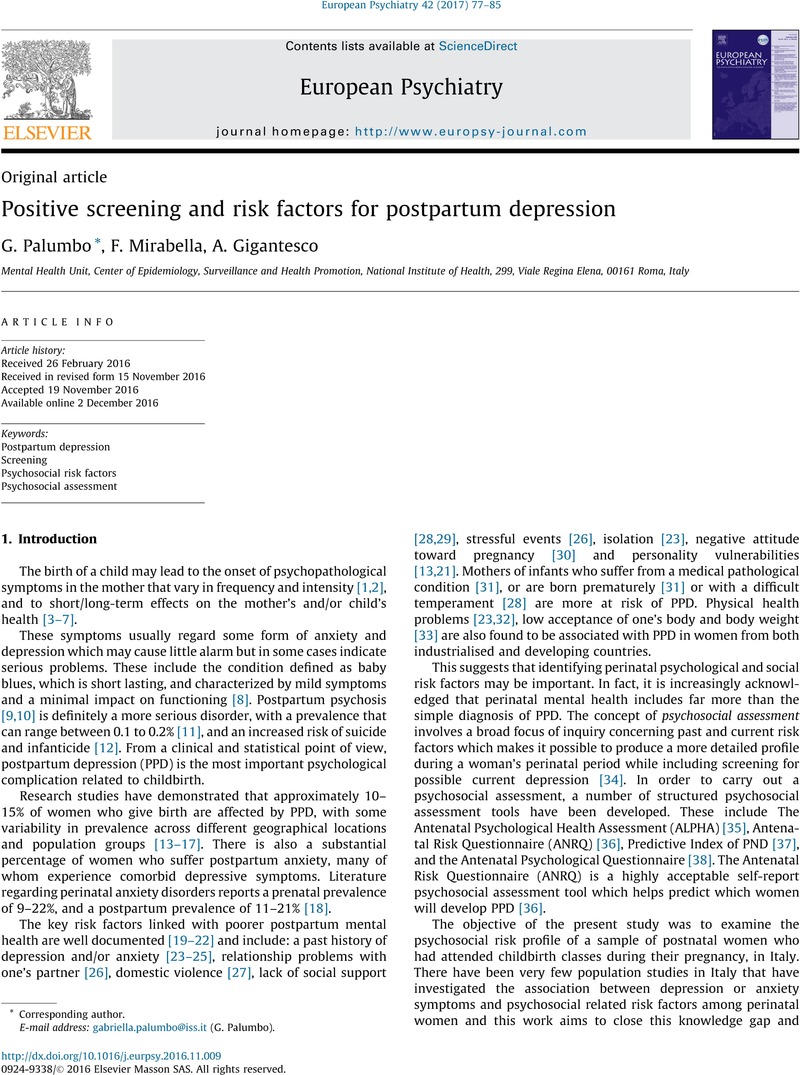Crossref Citations
This article has been cited by the following publications. This list is generated based on data provided by Crossref.
Nagle, Ursula
and
Farrelly, Mary
2018.
Women's views and experiences of having their mental health needs considered in the perinatal period.
Midwifery,
Vol. 66,
Issue. ,
p.
79.
Zhang, Senmao
Wang, Lesan
Yang, Tubao
Chen, Lizhang
Qiu, Xing
Wang, Tingting
Chen, Letao
Zhao, Lijuan
Ye, Ziwei
Zheng, Zan
and
Qin, Jiabi
2019.
Maternal violence experiences and risk of postpartum depression: A meta-analysis of cohort studies.
European Psychiatry,
Vol. 55,
Issue. ,
p.
90.
Leonard, Krista S.
Evans, M. Blair
Kjerulff, Kristen H.
and
Symons Downs, Danielle
2020.
Postpartum Perceived Stress Explains the Association between Perceived Social Support and Depressive Symptoms.
Women's Health Issues,
Vol. 30,
Issue. 4,
p.
231.
Vichi, Monica
Ghirini, Silvia
Roma, Paolo
Mandarelli, Gabriele
Pompili, Maurizio
and
Ferracuti, Stefano
2020.
Trends and patterns in homicides in Italy: A 34-year descriptive study.
Forensic Science International,
Vol. 307,
Issue. ,
p.
110141.
Sarli, Desi
Gunawan, Imam
Novinaldi
and
Poddar, Sandeep
2020.
Early screening of baby blues based on Android applications: First-week postpartum.
Enfermería Clínica,
Vol. 30,
Issue. ,
p.
129.
Grussu, Pietro
Lega, Ilaria
Quatraro, Rosa Maria
and
Donati, Serena
2020.
Perinatal mental health around the world: priorities for research and service development in Italy.
BJPsych International,
Vol. 17,
Issue. 1,
p.
8.
Cena, L.
Mirabella, F.
Palumbo, G.
Gigantesco, A.
Trainini, A.
and
Stefana, A.
2020.
Prevalence of maternal antenatal anxiety and its association with demographic and socioeconomic factors: A multicentre study in Italy.
European Psychiatry,
Vol. 63,
Issue. 1,
Abdul Aziz, Nurul Uyun
Chiroma, Samaila Musa
Mohd Moklas, Mohamad Aris
Adenan, Mohd Ilham
Ismail, Amin
and
Hidayat Baharuldin, Mohamad Taufik
2020.
Antidepressant-Like Properties of Fish Oil on Postpartum Depression-Like Rats Model: Involvement of Serotonergic System.
Brain Sciences,
Vol. 10,
Issue. 10,
p.
733.
Qiu, Xing
Zhang, Senmao
Sun, Xin
Li, Haiou
and
Wang, Donghua
2020.
Unintended pregnancy and postpartum depression: A meta-analysis of cohort and case-control studies.
Journal of Psychosomatic Research,
Vol. 138,
Issue. ,
p.
110259.
Qi, Weijing
Zhao, Fuqing
Liu, Yutong
Li, Qing
and
Hu, Jie
2021.
Psychosocial risk factors for postpartum depression in Chinese women: a meta-analysis.
BMC Pregnancy and Childbirth,
Vol. 21,
Issue. 1,
Gigantesco, Antonella
Palumbo, Gabriella
Cena, Loredana
Camoni, Laura
Trainini, Alice
Stefana, Alberto
Mirabella, Fiorino
and
Lupattelli, Angela
2021.
The limited screening accuracy of the Patient Health Questionnaire-2 in detecting depression among perinatal women in Italy.
PLOS ONE,
Vol. 16,
Issue. 11,
p.
e0260596.
Das, Anirudha
Gordon-Ocejo, Gloria
Kumar, Mohit
Kumar, Nitin
and
Needlman, Robert
2021.
Association of the previous history of maternal depression with post-partum depression, anxiety, and stress in the neonatal intensive care unit.
The Journal of Maternal-Fetal & Neonatal Medicine,
Vol. 34,
Issue. 11,
p.
1741.
Sakari, Philip Simiyu
Mwanzia, Lydia
and
Chesire, Irene
2021.
Postpartum depression and anxiety among mothers of preterm neonates in western Kenya.
African Journal of Midwifery and Women's Health,
Vol. 15,
Issue. 2,
p.
1.
Cena, Loredana
Gigantesco, Antonella
Mirabella, Fiorino
Palumbo, Gabriella
Camoni, Laura
Trainini, Alice
and
Stefana, Alberto
2021.
Prevalence of comorbid anxiety and depressive symptomatology in the third trimester of pregnancy: Analysing its association with sociodemographic, obstetric, and mental health features.
Journal of Affective Disorders,
Vol. 295,
Issue. ,
p.
1398.
YAKSI, Nese
and
SAVE, Dilsad
2021.
How do social and spousal support influence postpartum depression?.
Marmara Medical Journal,
Vol. 34,
Issue. 3,
p.
327.
Cena, Loredana
Gigantesco, Antonella
Mirabella, Fiorino
Palumbo, Gabriella
Trainini, Alice
and
Stefana, Alberto
2021.
Prevalence of Maternal Postnatal Anxiety and Its Association With Demographic and Socioeconomic Factors: A Multicentre Study in Italy.
Frontiers in Psychiatry,
Vol. 12,
Issue. ,
Camoni, Laura
Mirabella, Fiorino
Gigantesco, Antonella
Brescianini, Sonia
Ferri, Maurizio
Palumbo, Gabriella
and
Calamandrei, Gemma
2022.
The Impact of the COVID-19 Pandemic on Women’s Perinatal Mental Health: Preliminary Data on the Risk of Perinatal Depression/Anxiety from a National Survey in Italy.
International Journal of Environmental Research and Public Health,
Vol. 19,
Issue. 22,
p.
14822.
Masserdotti, Elisa
Tessarin, Silvia
Sofia Palmas, Maria
Capretti, Margherita
Beretta, Emanuela
Sartori, Enrico
and
Simonetti, Rita
2022.
Esperienza preliminare finalizzata all'individuazione del disagio psicologico perinatale in donne a rischio ostetrico ricoverate nel reparto di Ostetricia.
PSICOLOGIA DELLA SALUTE,
p.
137.
Qiu, Xing
Zhang, Senmao
and
Yan, Jin
2022.
Gestational weight gain and risk of postpartum depression: A meta-analysis of observational studies.
Psychiatry Research,
Vol. 310,
Issue. ,
p.
114448.
Qiu, X.
Sun, X.
Li, H.O.
Wang, D.H.
and
Zhang, S.M.
2022.
Maternal alcohol consumption and risk of postpartum depression: a meta-analysis of cohort studies.
Public Health,
Vol. 213,
Issue. ,
p.
163.




Comments
No Comments have been published for this article.